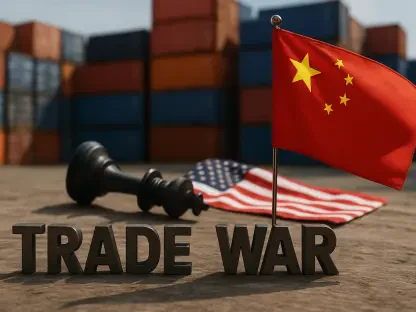Economic policies intended to address contemporary issues sometimes draw heavily from historical precedents, yet this reliance on the past can lead to significant miscalculations. When examining the economic strategies of recent administrations like those of Joe Biden and Donald Trump, it becomes apparent that policies influenced by history can backfire, leading to political and economic turmoil. By revisiting historical economic strategies and their implications, we can discern whether such tendencies contribute to political malpractice.
Biden Administration’s Stimulus Strategy
New Deal Echoes in Modern Policy
The Biden administration’s ambitious approach involved massive financial injections, aimed initially at countering the economic downturn induced by the COVID-19 pandemic. This strategy echoed the New Deal policies from the 1930s, characterized by substantial government spending to rejuvenate the economy. The fundamental idea was to invigorate consumer demand and mitigate the pandemic’s adverse effects on businesses and individuals. However, while the aim was to stabilize and spur the economy, the consequences were far from the rosy predictions.
These cash injections, albeit well-intentioned, rapidly fueled inflation—a problem that was initially dismissed as merely “transitory.” As more money entered the economy, demand surged, but supply chains, still grappling with pandemic-related disruptions, could not match this. Consequently, prices of goods and services rose sharply. Despite warnings from economists like Larry Summers and Jason Furman, who cautioned against such expansive spending, the administration proceeded, only to see inflation rates climb to levels unseen in decades. Voters, feeling the crunch of higher living costs, grew disenchanted with the administration, culminating in Biden’s and Harris’s political setbacks.
Political Blowback and Voter Discontent
The political ramifications of the Biden administration’s economic policies became particularly evident as inflation permeated everyday life. The cost of essentials such as groceries, gas, and housing soared, eroding consumer confidence. This inflation was not only a financial strain but also a significant political liability, leading to widespread disillusionment with the current leadership. As the electorate became increasingly burdened with high prices, it fostered a sentiment that the government was out of touch with the populace’s realities.
Inflation’s ripple effect on the political landscape was profound. The issue that many initially believed would recede grew into a defining feature of Biden’s presidency. Campaign promises of economic revival faded against the backdrop of escalating living costs, and the electorate’s patience wore thin. Ultimately, historical approaches, like those resembling the New Deal, failed to account for contemporary economic complexities, leading to political fallout and electoral defeat.
Trump’s Tariff Policies
Tariffs and Domestic Manufacturing
On the other side of the historical policy spectrum, Donald Trump’s administration fervently supported tariffs with the aim of invigorating American manufacturing. Tariffs, a protectionist strategy prevalent in early American economic practices, were expected to render imported goods more expensive, thus encouraging the consumption of domestically produced items. Trump’s policies particularly targeted steel and aluminum, hoping to revive industries suffering from cheaper foreign imports. However, this approach soon revealed its complications.
While the intention behind the tariffs was to protect American jobs and industries, the reality was more convoluted. Imposing tariffs on critical imports such as steel and aluminum not only strained relations with key trade partners like Mexico and Canada but also led to retaliatory measures. Domestic manufacturers faced higher costs for raw materials, impacting their competitiveness. Furthermore, consumers bore the brunt of these expenses as companies passed on the increased costs, leading to higher prices for various goods. Thus, rather than bolstering domestic manufacturing, tariffs introduced market instabilities and economic uncertainties that rippled through the economy.
Economic Disruption and Market Instability
The repercussions of Trump’s tariff policies were multifaceted and disruptive. Economists criticized the tariffs for creating an unpredictable business environment, which deterred investment and complicated long-term planning for businesses. The tariffs’ sporadic application further contributed to unpredictability, with Trump imposing and escalating tariffs based on shifting diplomatic and economic considerations. This sense of instability was detrimental, as stable trade relations are paramount for economic health and growth.
Moreover, the tariffs sparked tensions with essential trading partners. Canada’s retaliatory measures, for instance, strained a historically strong trade relationship, jeopardizing the benefits of collaborative economic activities. This tit-for-tat scenario not only soured international relations but also introduced additional economic risks. In the context of a globalized economy, such protectionist measures were at odds with the interconnected nature of modern trade, leading to significant economic disruptions both domestically and internationally.
The Flaws of Historical Precedents in Modern Policy
Misunderstood Historical Analogies
A recurring critique of both administrations’ strategies was their heavy reliance on historical analogies that may not have accounted for contemporary economic contexts. Biden’s stimulus measures and Trump’s tariffs, drawn from past economic policies, failed to consider crucial differences in today’s globalized and technologically advanced economy. As a result, these strategies highlighted the pitfalls of applying outdated economic theories without adjusting for present-day nuances.
For instance, the economic landscape during the New Deal era was vastly different from today. The industrial economy of the early 20th century does not mirror the service-oriented, digital, and globally interdependent economy of the 21st century. Similarly, the protectionist policies of the past do not align well with modern economic interdependencies. The complexities of today’s economic relationships require nuanced and adaptable strategies, yet both administrations leaned heavily on simplistic historical precedents, leading to unintended consequences.
The Need for Context-Aware Policymaking
Economic policies meant to address current issues often draw heavily from historical precedents, yet this reliance on the past can lead to notable miscalculations. Examining the economic strategies of recent administrations like those of Joe Biden and Donald Trump reveals that policies influenced by history can backfire, causing political and economic upheaval. For instance, Trump’s use of tariffs echoed past protectionist measures, which ultimately strained international trade relationships. Similarly, Biden’s ambitious infrastructure plans draw inspiration from the New Deal era but face modern challenges such as rapid technological changes and differing global economic conditions. By revisiting historical economic strategies and understanding their implications, we can determine if such tendencies contribute to political missteps. This reflection helps to understand whether historical strategies are adaptable or if they risk repeating past mistakes in today’s complex economic landscape.









